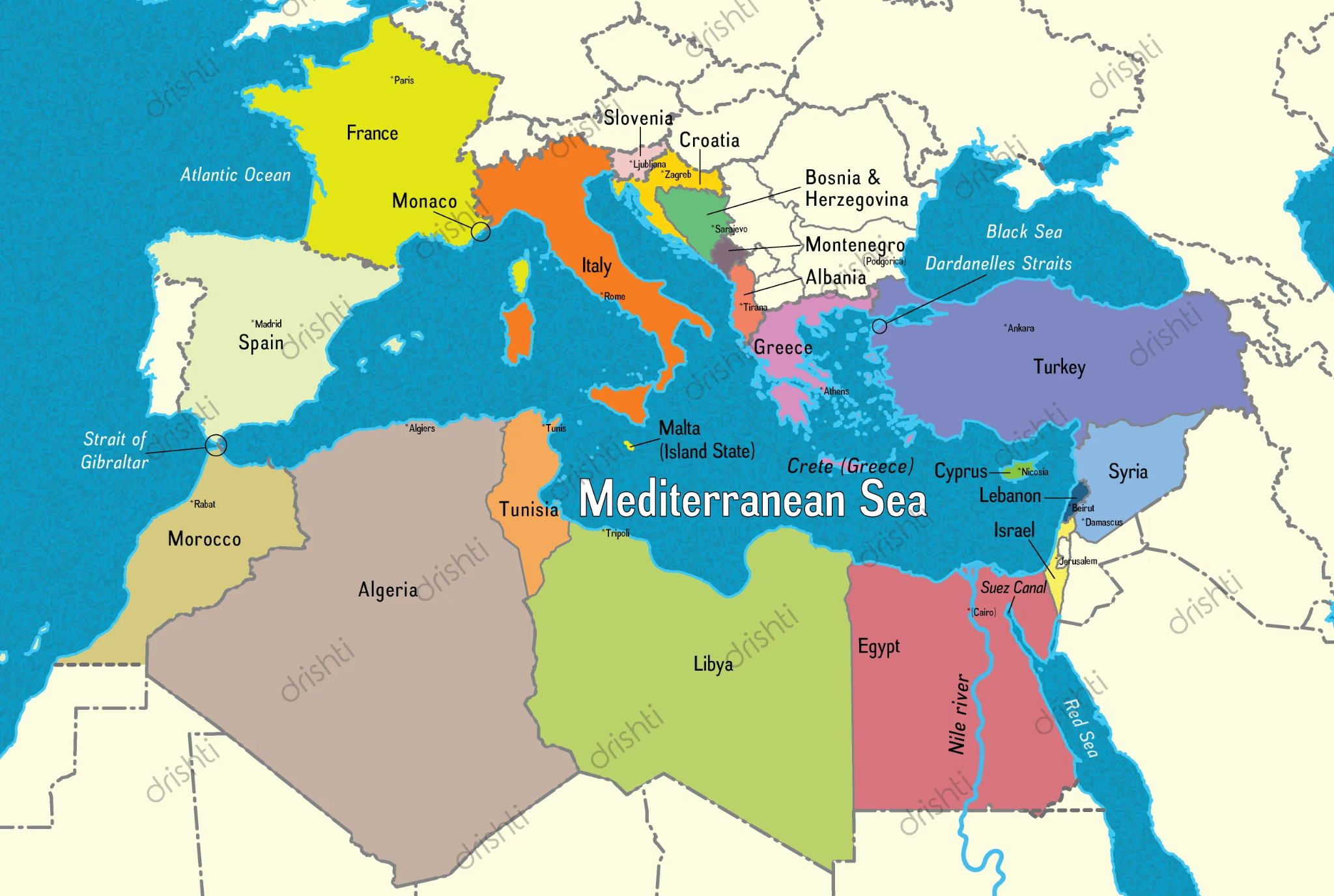Wildfires | 16 Aug 2025
Why in News?
Wildfires in Albania, Greece, Italy, Portugal, Spain, and Turkey have resulted in fatalities and forced thousands to evacuate the affected regions.
What are the Key Facts Regarding Wildfires?
- About: Wildfire is an uncontrolled fire in forests, grasslands, brushlands, or tundra, spread by wind and terrain, and sustained by fuel, oxygen, and heat.
- Classification:
- Surface Fire: Burns along the ground, consuming dry leaves, twigs, and grasses on the forest floor.
- Underground/Zombie Fire: Low-intensity fires burning organic matter beneath the surface, spreading slowly and often undetected, sometimes persisting for months.
- Canopy/Crown Fire: Spreads through the upper tree canopy, often intense and hard to control.
- Controlled Deliberate Fire: Planned burns by forest agencies to reduce fuel loads and support ecosystem health.
- Causes:
- Geography: Mediterranean climate regions are highly susceptible to wildfires, particularly during the hot, dry summer months, due to the combination of high temperatures, low humidity, and dry winds (E.g., Sirocco- hot wind that blows from the Sahara Desert to southern Europe and increases wildfire risk).
- Climate Change: Dry spells, erratic monsoons, unseasonal heat waves, and El Niño events dry vegetation and increase flammability.
- Human-Induced Factors: Slash-and-burn, agricultural expansion, infrastructure projects, tourism, and waste mismanagement trigger accidental and deliberate fires.
- Weak Fire Management & Technology: Inadequate surveillance, outdated response systems, lack of AI-based prediction, and poor weather-based forecasting delay control efforts.
- Biodiversity Loss & Flammable Vegetation: Dry deciduous forests, pine needles, bamboo groves, and monoculture plantations act as natural fuel, reducing native biodiversity.
- Deforestation & Habitat Fragmentation: Infrastructure, mining, unregulated grazing, and weak policy enforcement degrade forests, intensify human-wildlife conflict, and harm ecosystems.
- Impacts:
- Air Pollution & Climate Change: Wildfires release CO₂, PM2.5, Methane and other toxic gases, worsening air quality and contributing to global warming.
- Biodiversity & Habitat Loss: Forest destruction kills wildlife, threatens endangered species, and disrupts ecosystems.
- A study estimates that in 2020, wildfires in Brazil claimed the lives of nearly 17 million animals, including reptiles, birds, and primates, while causing severe biodiversity loss.
- Human Health Risk: Smoke inhalation leads to respiratory problems, eye irritation, heat-related injuries, and mental stress in affected populations.
- Economic Damage: Property destruction, firefighting costs, and agricultural losses strain economies.
- Soil & Water Degradation: Erosion and ash runoff pollute water sources, harming aquatic life and drinking water.
- Wildfires in India:
- According to the India State of Forest. Report (ISFR) 2021, more than 36% of the country’s forest cover was estimated to be prone to frequent forest fires. 2.81% of the country’s forest cover was extremely prone to fires, whereas 7.85% of forest cover is found to be very highly fire prone.
- Forest fire incidents have surged in mountain regions: Himachal Pradesh by 1,339%, Jammu & Kashmir by 2,822%, and Uttarakhand by 293% (ISFR 2023).
Common Wildfire Control Material & Method
- Pink Fire Retardant is a chemical mixture designed to slow or suppress wildfires.
- It mainly contains an ammonium phosphate-based slurry, with salts like ammonium polyphosphate and toxic metals such as chromium and cadmium.
- The Bambi Bucket is a special container hung under a helicopter, filled by dipping it into a water source like a river or pond, and emptied over a fire through a bottom valve.
- It is especially useful for tackling wildfires in hard-to-reach areas, and helicopters worldwide often use it to fight forest fires.
What Steps are Needed to Tackle Wildfires?
- Integrated Fire Management: Use prescribed burning, fuel load reduction, firebreaks, strict fire safety regulations, and public awareness to prevent uncontrolled fires.
- Community & Tribal Participation: Involve local communities, Van Panchayats, and tribal groups with training, livelihood incentives, and traditional conservation for early detection and response.
- Advanced Technology & Early Warning: Apply AI predictive models, satellite monitoring, drones, and real-time alerts for rapid containment.
- Ecosystem Restoration & Resilience: Support fire-resistant species, green firebreaks, climate-resilient forestry, wetland restoration, and sustainable agroforestry.
- Policy Enforcement & Eco-Sensitive Development: Enforce no-go zones for mining/infrastructure, use watershed management, sustainable tourism, and blockchain for transparent conservation funding.
|
Drishti Mains Question Examine the factors contributing to the rising frequency and severity of wildfires, and propose strategies for their effective mitigation. |
UPSC Civil Services Examination Previous Year Question (PYQ)
Prelims
Q. Consider the following: (2019)
- Carbon monoxide
- Methane
- Ozone
- Sulphur dioxide
Which of the above are released into the atmosphere due to the burning of crop/biomass residue?
(a) 1 and 2 only
(b) 2, 3 and 4 only
(c) 1 and 4 only
(d) 1, 2, 3 and 4
Ans: (d)
Q. In the grasslands, trees do not replace the grasses as a part of an ecological succession because of (2013)
(a) insects and fungi
(b) limited sunlight and paucity of nutrients
(c) water limits and fire
(d) None of the above
Ans: (c)
Mains
Q. Most of the unusual climatic happenings are explained as an outcome of the El-Nino effect. Do you agree? (2014)

